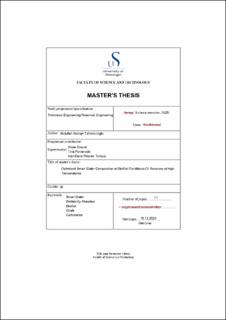| dc.contributor.author | Tahmiscioğlu, Abdullah Numan | |
| dc.date.accessioned | 2022-12-19T08:49:49Z | |
| dc.date.available | 2022-12-19T08:49:49Z | |
| dc.date.issued | 2020-12 | |
| dc.identifier.uri | https://hdl.handle.net/11250/3038388 | |
| dc.description | Master's thesis in Petroleum Reservoir Engineering | en_US |
| dc.description.abstract | Seawater has been performing as a wettability modifier in chalk reservoirs and has been used for this purpose for a long time. This wettability alteration enhances microscopic then overall displacement efficiencies. Having the wettability-altering capability makes seawater possible to spontaneously imbibe into the chalk matrix and produce extra oil. Studies show that Ca+2,SO4-2, and Mg+2, potential determining ions, can be chemically active and desorbs the organic oil acids from the chalk mineral surface. This release of organic oil acids provides more water-wet wetting conditions for the reservoir mineral surfaces hence allowing more oil to be produced.
Smart Water is a designed injection brine that can modify reservoir wettability towards water wet. Knowing that seawater already functioning as a Smart Water in chalk reservoirs, to design the ideal Smart Water, seawater is considered as a base injection brine. Smart Water for chalk needs to be abundant in Ca+2, SO4-2, and Mg+2 concentrations. It is also shown that low Na+ and Cl concentrations help better displacement performance.The wettability alteration capability of Smart Water is directly related to reservoir temperature as well. Although slight Smart Water effect may be observed in low temperatures ~90 ºC, as temperature increases to ~130 ºC significant wettability alteration by Smart Water is observed.
In this thesis, finding composition, concentration, and stable equilibrium conditions for Smart Water is aimed. Stevns Klint chalk cores were used for their analogical importance to Ekofisk Field. Experiment temperature was also chosen as reservoir temperature of Ekofisk, 130 ºC to provide a better resemblance.
In total, four cores were cleaned with de-ionized water, restored 10% Swi with sulfate-free formation water, and 90% Soi with oil of AN:0.53 mgKOH/g. All cores aged for 14 days at 130 ºC. After a batch test, Smart Water is decided to be prepared as a 10 M CaSO4 solution.
Spontaneous imbibition test with formation water recovered 30% of OOIP; seawater 58% of OOIP and CaSO4 30% of OOIP in secondary mode. In tertiary mode, CaSO4 showed a slight wettability alteration and recovered an extra 8% of OOIP while seawater illustrated remarkable wettability modification and recovered 55% of OOIP after 30% of OOIP with formation water.
Seawater also experimented in tertiary mode and recovered 54% of OOIP after 30% of OOIP with CaSO4 solution. This confirms the wettability alteration capabilities of seawater. | en_US |
| dc.language.iso | eng | en_US |
| dc.publisher | University of Stavanger, Norway | en_US |
| dc.relation.ispartofseries | Masteroppgave/UIS-TN-IER/2020; | |
| dc.rights | Attribution-NoDerivatives 4.0 Internasjonal | * |
| dc.rights.uri | http://creativecommons.org/licenses/by-nd/4.0/deed.no | * |
| dc.subject | Carbonate Reservoirs | en_US |
| dc.subject | Ekofisk Field | en_US |
| dc.subject | smart water | en_US |
| dc.subject | wettability alteration | en_US |
| dc.subject | carbonate reservoirs | en_US |
| dc.title | Optimized Smart Water Composition at Ekofisk Conditions | en_US |
| dc.title.alternative | Oil Recovery at High Temperatures | en_US |
| dc.type | Master thesis | en_US |
| dc.subject.nsi | VDP::Matematikk og Naturvitenskap: 400::Geofag: 450::Petroleumsgeologi og -geofysikk: 464 | en_US |
| dc.subject.nsi | VDP::Teknologi: 500::Berg‑ og petroleumsfag: 510::Petroleumsteknologi: 512 | en_US |

